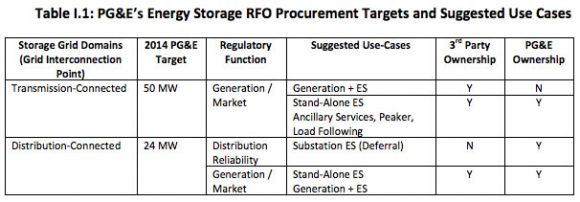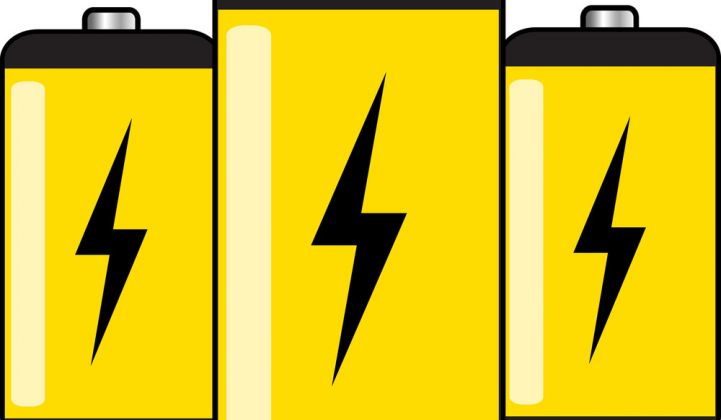Four years ago, the California legislature put an energy storage revolution into motion with the passage of AB 2514. That revolution is now starting to get underway as California's largest investor-owned utilities this week issued the first requests for energy storage offers to meet the goal of 1.3 gigawatts by 2022.
“2014 will be viewed as the year in which utilities started to embrace energy storage for the versatile technology that it is to solve various problems along the grid,” said Ravi Manghani, senior energy storage analyst with GTM Research.
Southern California Edison
SCE did not wait around for the first procurement round to seek out energy storage. The utility has already awarded contracts for more than 250 megawatts of energy storage for its local capacity requirement request, a long-term plan to bring about 2,200 megawatts of grid resources on-line by 2022 to help the Los Angeles and Orange County regions make up for the closure of the San Onofre nuclear power plant.
To meet the requirements set forth in AB 2514, SCE put out a request for an additional 16.3 megawatts on Monday. SCE is looking for resources under two structures, one in which SCE would set up a power-purchase agreement only for resource adequacy, and another where the storage assets provide not only power but also ancillary services. Offers are due by April 1, 2015.
Pacific Gas & Electric
PG&E is seeking 74 megawatts of energy storage, 50 megawatts on the transmission grid and an additional 24 megawatts on distribution circuits. The utility is considering owning the assets, except for energy storage that will be used as a generation asset connected to the transmission system.

The utility notes that the target of 10 megawatts of customer-connected energy storage is largely already met in the 9 megawatts of existing projects, so PG&E does not expect the last megawatt to be met through the current RFO.
Overall, PG&E issued a broader request for offers, said Manghani. The utility is looking for storage to be installed as standalone assets or on existing PG&E-owned solar plants, and even in terms of ownership, it will accept power-purchase agreements, as well as agreements to build and transfer to utility applications.
Offers are due by February 17, 2015.
PG&E and SCE are hardly alone in issuing energy storage RFOs in 2014. “These announcements provide major momentum for the industry and come at the heels of several other procurement announcements this year,” said Manghani.
San Diego Gas & Electric
The third large California utility, San Diego Gas & Electric, issued its first RFO to meet AB 2514 this summer as part of its local capacity requirement (LCR) strategy. It calls for a minimum of 25 megawatts of storage, but allows for a maximum of 800 megawatts of energy storage systems that could be procured. Similar to SCE, which was required to get at least 50 megawatts of energy storage under its LCR strategy but ended up with 250 megawatts, the outcome of SDG&E’s RFO could be far more energy storage contracts than the base requirement.
Also in California, Imperial Irrigation District issued a broad, 40-megawatt energy storage request to address a range of grid reliability issues, including ramping, frequency regulation, capacity, system reliability and power quality. In May, it announced a short list of nine vendors that will be considered for the final solicitation.
Energy storage requests aren’t solely the domain of California’s big utilities. New Jersey issued a small $3 million solicitation in October for energy storage projects that will add resiliency to the state’s power grid and provide backup to critical services during prolonged outages, such as Superstorm Sandy.
In Hawaii, Kauai Island Utility Cooperative issued an RFP for storage to further enable solar penetration in its territory, which was at more than 5 percent in 2013 and is expected to be about 16 percent in 2014.
Earlier this year, Hawaii Electric Co. launched one of the biggest energy storage proposals in the country, quietly opening up requests for proposals for 60 to 200 megawatts of storage projects that could provide about 30 minutes of storage to help balance the wind and distributed solar that are straining Oahu’s grid.
Ontario’s Independent Electricity System Operator awarded about 34 megawatts of energy storage projects in July as part of its mandate to bring 50 megawatts to the province by the end of 2014. Ontario is using energy storage for ancillary services, voltage control and reactive power support as it also balances more wind and solar on its system. In April, Ontario became the first jurisdiction in North America to eliminate coal from its electricity generation mix.



